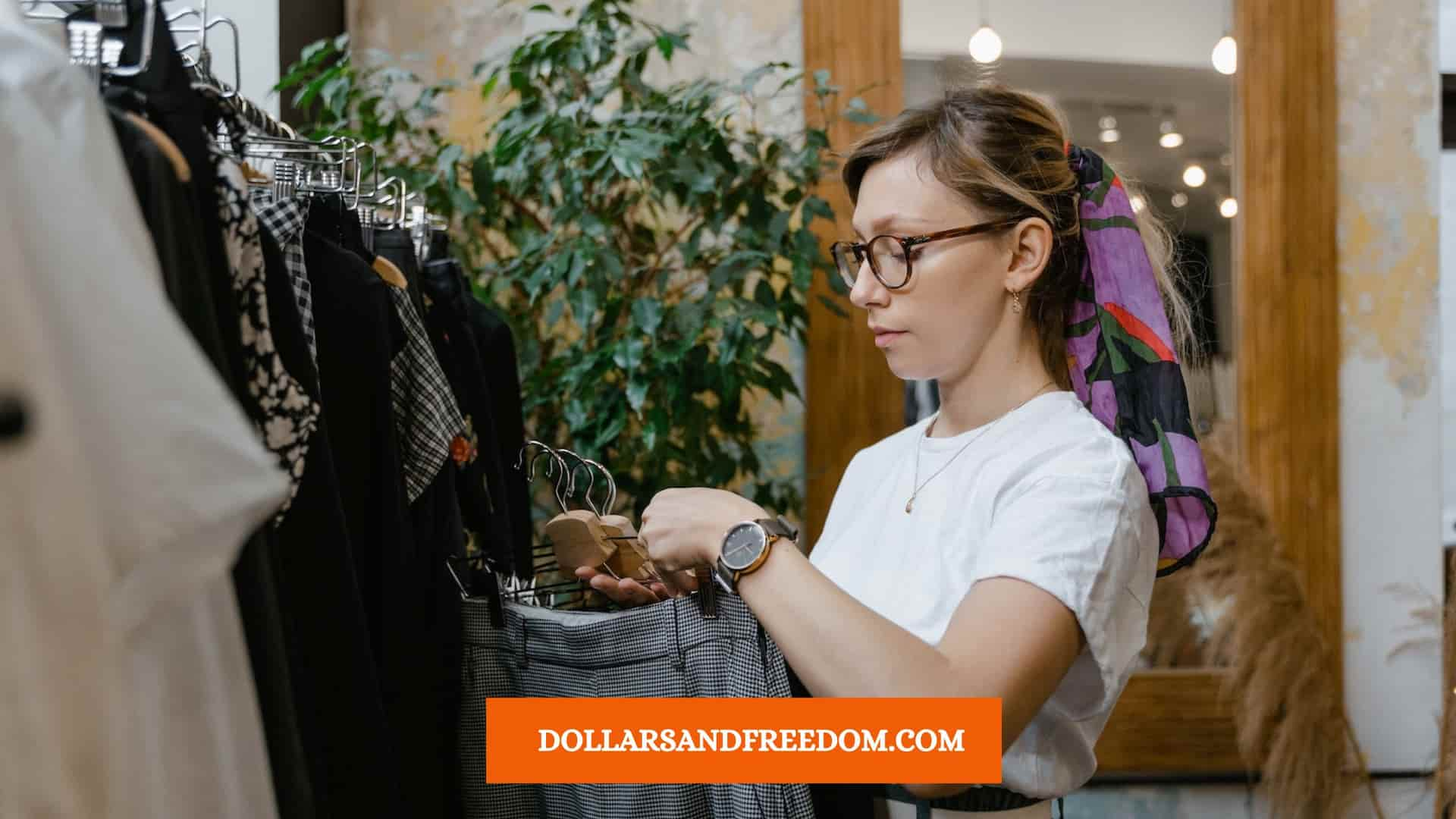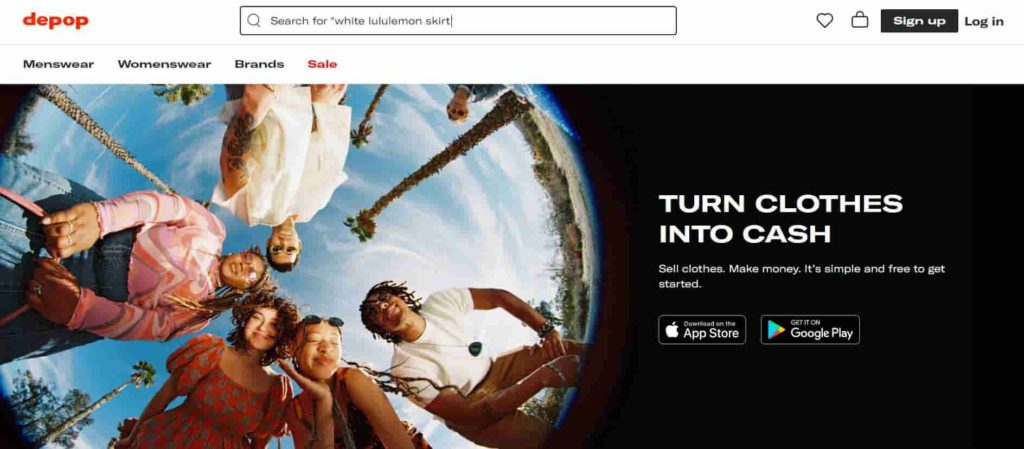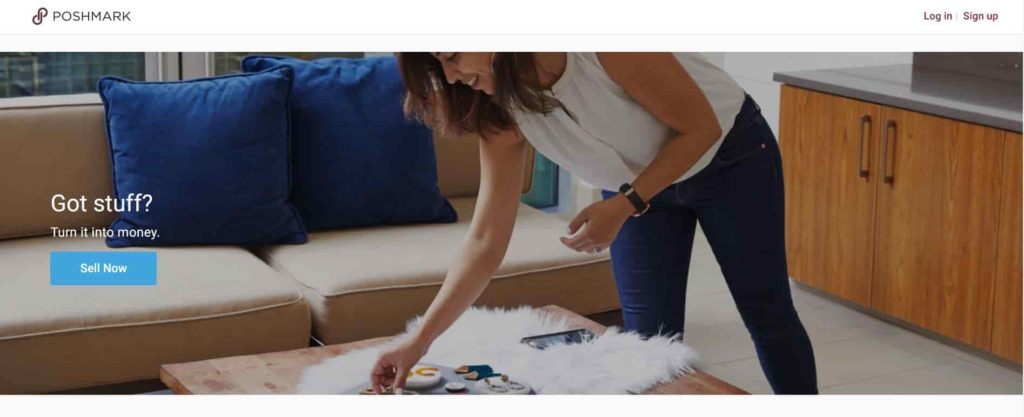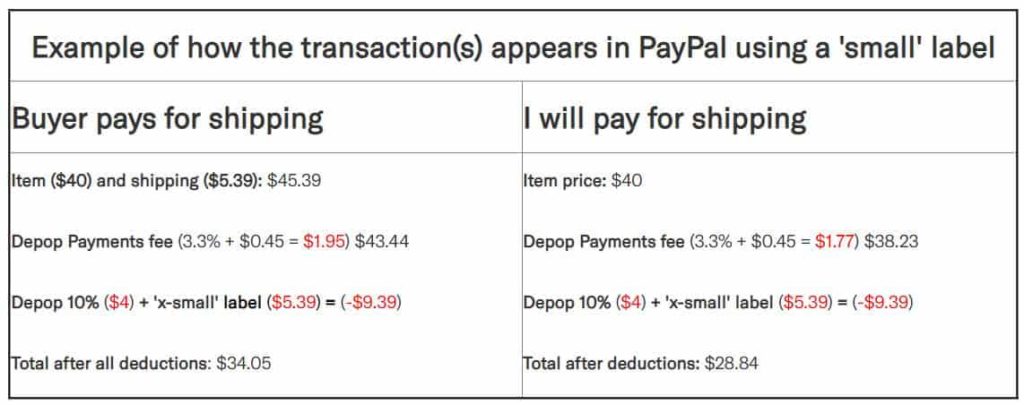Is Depop or Poshmark Better? [Depop vs Poshmark For Sellers 2024]

This post may contain affiliate links. Therefore, should you click and make a purchase with these links, we may earn a small commission at no extra cost to you. On DollarsAndFreedom, we recommend only the best for our readers. For more information, visit our Disclaimer Page.
Depop and Poshmark are popular online platforms to sell secondhand clothing. If you want to sell off the clothes you no longer wear, you may be at the crossroads not knowing which of the platforms to join.
Receive financial tips, side hustle ideas, money-saving tips, and more.
Which platform is better for sellers – Depop or Poshmark? This article is the ultimate guide to help you decide which platform to join to make money off your used clothing.
So, without wasting much time, let’s get going!
Overview Of Depop Vs Poshmark
Depop and Poshmark are both popular online marketplaces for selling secondhand clothing.
However, there are some key differences between the two platforms that may make one a better fit for your needs than the other if you are looking to sell off your slightly used clothing.
I’ve done my best to outline the strengths of both Depop and Poshmark. They both excel in the selling department, so you can choose the one that aligns better with your specific selling preferences.
Here is a quick comparison of Depop and Poshmark for sellers:
Feature | Depop | Poshmark |
Types of clothing sold | Depop is for selling vintage, streetwear, and high-end fashion clothing. | Poshmark is for selling contempory, name-brand clothing. |
Target Audience | Depop targets young buyers usually 25 years and under who are looking for unique and vintage fashion items. | Poshmark targets older buyers and millennials who are looking for good deals on known clothing brands. |
Seller fees | 10% of the selling price, plus 2.9% + $0.30 for sellers in the U.S. | 20% of the selling price, plus a $2.95 flat fee. |
Listing fees | None | None |
Shipping | Sellers have the option to either handle the shipping themselves or arrange in-person meetups. The shipping costs are covered by the buyers. | Poshmark streamlines shipping by offering prepaid labels for every order. Buyers pay a fixed shipping fee, regardless of the item's weight or size. |
Seller experience | Depop creates a social and community-oriented environment where sellers can engage with buyers through direct messaging, fostering the opportunity to establish connections and relationships. | Poshmark offers a more straightforward and transaction-focused atmosphere. Sellers can't directly interact with buyers, but they can leave comments on items and engage in public Posh Parties. |
About Depop

Image Source: Depop
Depop was launched in 2011 by Simon Berckerman, but it was just a social network where PIG magazine’s readers could purchase items from young artists and designers featured in the magazine.
The site remained this way for some time but was changed into an online marketplace for young folks. In 2021, Depop was acquired by Etsy, which is one of the biggest e-commerce platforms focusing on vintage and handmade items.
Depop proudly agrees that about 90% of its users are below 26 years old. So, this platform is mainly used by Gen-Zs. It’s likely that most people who are 35 years and older haven’t used or heard of Depop.
Currently, Depop has over 21 million registered users worldwide. The Depop app is available for both Android and iOS devices.
As a seller on Depop, you can sell items like vintage, streetwear, and high-end fashion clothing (these are the popular products on Depop). However, you can still list other items including sneakers, boots, jewelry, tank tops, hats, and many others.
Depop Interesting Statistics
- Depop had a 300% revenue growth in 2020 during the pandemic.
- Depop has about 1.8 million active sellers and 3.1 million active buyers.
- Depop made a revenue of $85 million in 2022.
- Depop was acquired by Etsy for $1.6 billion.
About Poshmark

Image Source: Poshmark
Poshmark is also an online social marketplace for selling secondhand clothing, but new ones can also be sold on the site.
Poshmark was founded in 2011 by Manish Chandra and other three co-founders. Since its launch, Poshmark has expanded to include more than 80 million users, with the majority being 35 years and above.
The platform primarily attracts older buyers and millennials seeking great bargains on well-known clothing brands.
Poshmark is actively available in only the United States, Canada, and Australia. As a seller, you can download the Poshmark app on both Google Play and AppStore.
After that, you can list several items on the platform. Poshmark allows the selling of secondhand clothing of all styles, including those for men, women, kids, pets, homes, etc.
Poshmark Interesting Statistics
- Poshmark has about 8 million active sellers and 7.8 million active buyers (making it approximately four times the size of Depop).
- As of 2019, Poshmark had over 75 million listings.
- Poshmark generated $262 million in revenue in 2022.
Depop Vs Poshmark – Which Is Better For Selling Clothing?
When it comes to deciding where to sell your secondhand clothing, there are quite a few factors to weigh in. Things like how easy the platform is to use, the fees for sellers, listing costs, shipping, who your potential buyers are, the payment process, and seller protection are all important considerations.
That’s why I’ve gone ahead and done a head-to-head comparison of Depop and Poshmark across all these factors. My aim is to make it super simple for you to figure out which one suits your selling goals best.
1. Types of Clothing That Sell
Just because Depop and Poshmark are online platforms for selling secondhand clothing does not mean you can just list any items on the sites as a seller and make some good sales.
Depop and Poshmark each have specific types of clothing that perform well on their platforms due to their distinct target audiences.
So, let’s compare, Depop vs Poshmark for us to know the specific types of clothing that sell on each platform.
Depop

The types of clothing that perform well on Depop are vintage, one-of-a-kind, thrifted, streetwear, and high-end fashion clothing. And that’s not surprising because about 90% of Depop users are aged 26 and below.
So, if you’re looking for success as a seller on Depop, it’s crucial to ensure that the clothing you offer falls into these categories, catering to the platform’s majority Gen-Z audience.
Poshmark

In contrast, Poshmark users tend to be primarily aged 35 and above, representing millennial shoppers who are on the lookout for great deals on well-known clothing brands.
So, if you decide to go with Poshmark as your platform for selling secondhand clothing, it’s a good idea to ensure that your clothing items include recognizable brands such as Gucci, Michael Kors, Chanel, Louis Vuitton, Nike, Coach, Lululemon Athletica, and Kate Spade.
This aligns with the preferences of the platform’s user base. In fact, these are just a few of them. There are over 5,000 major brands on Poshmark.
2. Seller Fees
To also know whether Depop or Poshmark is better for selling clothing, we have to compare the seller fees of each platform.
When it comes to online marketplaces, there’s a variety of seller fee policies. Some let you list items for free but take a percentage of the sale price, while others might require an upfront listing fee with no additional costs after a sale.
So, let us have a look at the seller fees of Depop and Poshmark for you to decide what’s best for you. But don’t forget, both platforms give you the perk of free listings.
Depop
For every sale you make, you will be charged 10% of the selling price by Depop. But if you are residing in the United States, you will be charged an additional 2.9% + $0.30. Also, sellers in the U.K. are charged an additional 3.49% + £0.30.
To break it down, let’s say you sell a $25 shirt. In this case, you’d pay $2.50 as seller fees. If you’re in the U.S., you’d also incur additional fees of $0.73 plus $0.30.
Poshmark
On Poshmark, sellers pay a flat fee of $2.95 on sales made where the item costs less than $15. However, for items priced above $15, you are charged 20% of the price.
So, in comparison, Depop wins the seller fees battle. It will only be wise to sell items that cost less than $15 on Poshmark.
Seller fees Winner [Depop vs Poshmark]: Depop wins!
3. Shipping Fees
Let us also compare the shipping process and fees on Depop and Poshmark because this is a very important factor to consider when deciding which platform is better.
Depop
This is how shipping on Depop works: as a seller who is shipping from the U.S., you can choose to make your own shipping arrangement without involving Depop.
Alternatively, you can use Depop with USPS if the shipping is just within the mainland U.S. Since Depop has already partnered with USPS you can get a shipping label for the shipping.
But here’s the thing, regardless of your choice, you’ll need to decide whether you’ll foot the bill for shipping or pass that responsibility to the buyer.
For easy understanding, if you’ve sold an item for $40, here’s the difference between paying for shipping and having the buyer cover the costs.

Image Source: Depop
Poshmark
On Poshmark, the shipping fee is always paid by the buyer. Poshmark charges a $7.97 flat fee for shipping if the package is less than 5 lbs. And the shipping is done through USPS.
Moreover, Poshmark gives a timeframe for shipping to be completed and that is within 2 weeks. If it exceeds 2 weeks, the buyer can make a complaint for a refund.
Shipping fees winner [Depop vs Poshmark]: It’s a draw because the Depop and Poshmark shipping process and fees are very similar.
4. Usability or Ease-Of-Use
Ease-of-use or usability is also very important when choosing a site for selling your clothing. Let us look at how usability is on both Depop and Poshmark.
Depop
The Depop app is very easy to use. It can be downloaded on both Google Play and App Store. You can also visit Depop’s website via your desktop computer.
After creating your account, you can start listing your items. Listing of items is a seamless process that should be done within a few minutes.
Frankly speaking, navigating the Depop platform is easy so as a seller, you will have a good experience.
Poshmark
Poshmark’s usability is the same as Depop’s. You can visit the site via desktop or get the app for your Android or iOS device. Account creation and listing of items are very simple to get done as well.
Usability winner [Depop vs Poshmark]: It’s a draw. Both platforms are very easy to use.
5. Payment Process
How do you get paid once you have made sales on both platforms? Let’s compare the payment process of Depop and Poshmark.
Depop
Depop pay through PayPal or Stripe, and the cool thing is that you can cash out on the same day after making a sale. All you have to do is link your PayPal or Stripe account to Depop and you get paid instantly.
Poshmark
On Poshmark, you are able to cash out through many methods, like direct deposit to your bank, checks, PayPal, and Venmo.
However, the only setback is that you can only cash out after the buyer has received and accepted the product purchased from you. If the customer is satisfied, you can receive your money within 3 days.
Payment process winner [Depop vs Poshmark]: It’s a draw. Both Depop and Poshmark have an easy payment process. Plus, there are no payment processing fees attached.
6. Seller Protection
How well are you protected as a seller on both platforms? This is another important question to ask, because in a situation where a buyer doesn’t receive the items you shipped; you want to know how you will be protected.
Let me take you through how Depop and Poshmark protect sellers against chargebacks or disputes.
Depop
As a seller, you are covered on Depop if you receive payment using the acceptable payment methods of the site. Furthermore, you must use tracked postage to ship your items to buyers. You also have to keep the receipt of the shipping.
However, if you go your own way without using Depop’s payment method, you will be on your own when there’s a problem.
Poshmark
Poshmark’s seller protection is quite similar. If you use the USPS label for your shipping, you will be fully covered if the items get lost or damaged.
Also, if the items you shipped cost $400 or more, the customer is supposed to sign upon delivery for extra protection.
Seller protection winner [Depop vs Poshmark]: Poshmark has better protection compared to Depop. Poshmark wins.
7. Social Media Presence
Social media presence is also a crucial factor to consider because a platform that has a good social presence means you can dwell on that as a seller to get more eyes on your products.
In an era where most people are on social media, you have to choose an online platform that helps you promote your store or products. So, let us compare the social media presence of Depop and Poshmark.
Depop
Depop allows sellers to promote their products on social media. The platform is built like Instagram, so it encourages sellers to post more on IG.
Also, Depop automatically shares your listings to buyers on the platform by displaying your products in their newsfeeds.
Poshmark
You can also reach thousands of people through Poshmark. You can chat, comment, and engage with other sellers, and they can do the same on your listings.
Plus, because Poshmark is for millennials, the platform has a Facebook-like appearance. And it’s good because your listings can appear in front of people even if they don’t follow you.
Social media presence winner [Depop vs Poshmark]: It’s a draw.
Is Depop or Poshmark Better For Selling Clothing?
Depop and Poshmark are both great for selling, but Depop shines if you’re into selling vintage and high-quality designer clothing, especially since it’s a go-to platform for Gen-Zs. The added perk is that Depop welcomes sellers from all corners of the globe, so you can list your items worldwide.
When it comes to seller fees, Depop keeps it reasonable, charging only 10% of your selling price, with an additional 2.9% + $0.30 if you’re in the U.S. This is generally lower than the seller fees on Poshmark.
Plus, Depop’s social vibe is like Instagram, making it easy to promote your products to your followers if you’ve got a substantial following already.
Conversely, Poshmark stands out if you’re into selling contemporary, well-known clothing brands. It’s the place to be because most Poshmark users are savvy millennial shoppers searching for deals on popular clothing labels.
While it’s true that Poshmark has somewhat higher seller fees, the platform makes up for it with enhanced seller protection when it comes to chargebacks or disputes. If you’re a fan of Facebook, you’ll probably find Poshmark’s platform pretty comfortable because it shares that same social-friendly vibe.
However, it’s worth noting that Poshmark operates exclusively in the United States, Canada, and Australia. So, you need to be located in one of these countries to sell on the platform.
Final Words
Depop and Poshmark are both good for selling secondhand clothing. Join Depop if you want to sell vintage, streetwear, or high-quality designer clothing since the majority of Depop users are below 26 years old.
In contrast, join Poshmark if you want to sell contemporary popular brand clothing since the majority of Poshmark users are above 35 years old (millennial shoppers).
All in all, both Depop and Poshmark are good platforms for selling. I hope that this comparison article helped you decide which platform suits you best.
Wishing you the very best of luck! Happy selling!

Manuelo is an entrepreneur and a personal finance nerd. He is the founder of Dollars And Freedom. An expert in side hustles, online gigs, and everything about making money. His works have been featured on major financial publications, like Business Insider, GoBankingRates, Investopedia, Entrepreneur, and more. When he’s not busy with his blog or writing for others, you’ll catch him hanging out with loved ones or reading books on stoicism and self-development.

Having numerous avenues for generating income can be overwhelming, especially if you're unaware of the most effective methods to begin earning. Here are some exceptional side hustle ideas that can help you start earning money.




![How To Turn $1000 Into $10000 [Legit Ways To 10x Your Money]](https://dollarsandfreedom.com/wp-content/uploads/2023/09/VS-4-1-2-768x432.jpg)
![Premise App Review [Update]: Is This App Legit or Scam?](https://dollarsandfreedom.com/wp-content/uploads/2023/11/VS-5-1-768x432.jpg)
